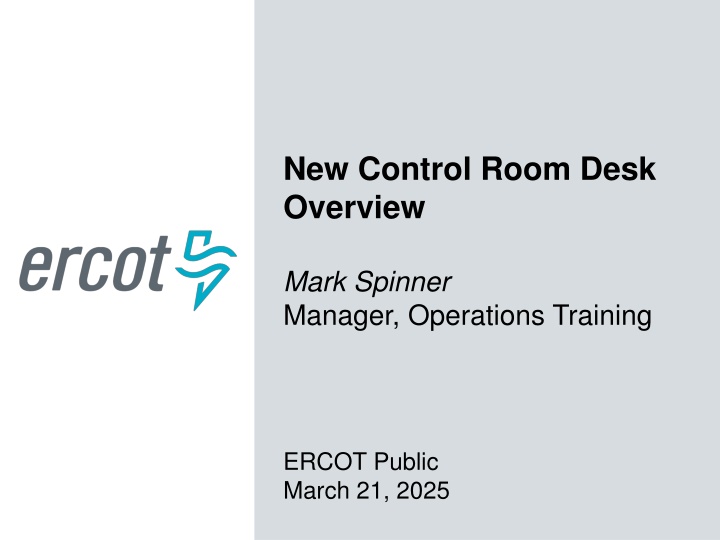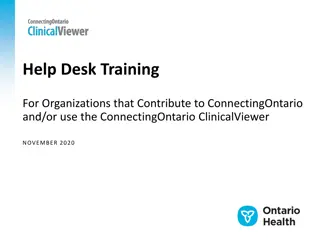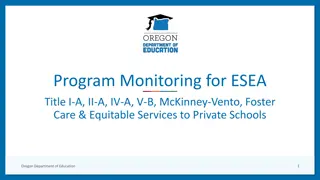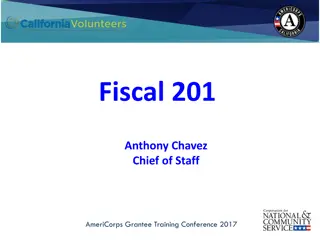
ERCOT Control Room Operations and Risk Management Overview
Explore the traditional and evolving risks faced by ERCOT operators in the control room, from transmission outages to frequency response following unit trips. Learn about risk assessment, frequency response stages, system inertia, and more. Discover how ERCOT manages operational reliability through contingency analysis, operating reserves, and operator judgment. Stay informed on the changing resource mix and the need for improved risk analysis and controls. Experience a deep dive into operational monitoring and analysis practices for enhanced reliability.
Download Presentation

Please find below an Image/Link to download the presentation.
The content on the website is provided AS IS for your information and personal use only. It may not be sold, licensed, or shared on other websites without obtaining consent from the author. If you encounter any issues during the download, it is possible that the publisher has removed the file from their server.
You are allowed to download the files provided on this website for personal or commercial use, subject to the condition that they are used lawfully. All files are the property of their respective owners.
The content on the website is provided AS IS for your information and personal use only. It may not be sold, licensed, or shared on other websites without obtaining consent from the author.
E N D
Presentation Transcript
New Control Room Desk Overview Mark Spinner Manager, Operations Training ERCOT Public March 21, 2025
Objectives List the four traditional risks that Operators encounter. Identify how risk assessment is performed. List the four stages of frequency response due to a generating unit loss. Identify which type of generating units can provide system inertia. Recall ERCOTs Critical Inertia level. List the Reliability Risk Desk tasks. 2 ERCOT Public
Traditional Operational Risks ERCOT operators deal with a variety of traditional risks in the Control Room: Transmission Outages Generation Resource Outages Load Forecast errors Base Point Deviations Operational Monitoring and Analysis 3 ERCOT Public
Traditional Operational Risks Control Room primarily assesses risk to operational reliability through: Contingency Analysis Operating reserves Informed, experienced operator judgment Operational Monitoring and Analysis Operating Actions 4 ERCOT Public
Evolving Risks Traditional Needs Evolving Needs With the changing resource mix on the system, the need to assess and manage certain risks has grown Operational Monitoring and Analysis Operating Actions Operating Actions 5 ERCOT Public
Evolving Risks Traditional Needs Evolving Needs Improved quantitative analysis and dynamic consideration of these risks and controls are needed Operational Monitoring and Analysis Operating Actions Operating Actions 6 ERCOT Public
Evolving Risks Traditional Needs Evolving Needs Perform existing activities with more in-depth monitoring and analysis Operational Monitoring and Analysis Operating Actions Operating Actions 7 ERCOT Public
Frequency Response following a Unit Trip 8 ERCOT Public
Design Criteria To Interconnection Obligation, ERCOT must plan not to activate UFLS for the simultaneous trip of the two STP units. consistently meet BAL-003 Response Frequency Under frequency Load Shed (UFLS) relays will shed firm load if frequency drops to 59.3 Hz (5% of total ERCOT load) 9 ERCOT Public
Facts Only synchronous machines provide inertia to the system Everything else provides a response, but does not provide system inertia 10 ERCOT Public
Frequency Response Initial rate of change of frequency (RoCoF) prior to any resource response is solely a function of inertia 11 ERCOT Public
Frequency Response Slope of the RoCoF line changes due to resources response Re-dispatch to 60 Hz AGC Governor Response 12 ERCOT Public
Rate of Change of Frequency Higher Inertia Lower Inertia 13 ERCOT Public
Response Time Early response is triggered earlier after the unit trip (e.g. a Resource that triggers at 59.8Hz would respond earlier than a Resource that triggers at 59.7Hz, all else equal) Fast response is delivered faster after the unit trip (e.g. a Resource that trips within 15 cycles is faster than one that trips within 30 cycles) 14 ERCOT Public
Response Times Load Resources (LR) providing RRS have underfrequency relays that respond in about 0.5s after the frequency drops below the trigger level (currently 59.7Hz) Governors of thermal generating units begin to respond immediately but will take a few seconds to provide significant response (requires more steam or more combustion) 15 ERCOT Public
Inertia Issues Must maintain at least a Critical Inertia Level that is based on the current operation practices and characteristics of frequency responsive resources As system inertia approaches critical level, RRS requirements increase exponentially 16 ERCOT Public
RRS Required as Critical Inertia is Approached Primary Frequency Response(MW) 8000 Studies have shown that the amount of RRS (if all provided by gen) required goes up asymptotically as inertia approaches the critical level 7000 Primary Frequency Response(MW) 6000 5000 4000 3000 2000 1000 0 50 100 150 200 250 300 350 400 Inertia (GW s) 17 ERCOT Public
Critical Inertia The level of inertia which causes the frequency to drop below the UFLS trigger before the fastest resources can provide sufficient frequency response (for the two STP trip) is the Critical Inertia 0.4 Hz 0.5 s 18 ERCOT Public
Critical Inertia Currently, the Critical Inertia Level for ERCOT appears to be around 100 GW s (based on current operations and response characteristics of current resources) Simulation results have shown that this is level at which RoCoF is high enough that frequency would drop below 59.3 HZ for the two STP trip Simulation results have also shown wide-area voltage oscillations at inertia below this level 19 ERCOT Public
Critical Inertia Solutions Bring more synchronous units online Use resources that activate earlier Use resources that are faster 20 ERCOT Public
Impact of Resource Types Load Resources help to lower the Critical Inertia Level and reduce the quantity of RRS needed as inertia approaches critical level (fast MW/s) Separating LRs so that some respond earlier (at 59.8Hz, e.g.) could provide additional improvement Moving some LRs to respond faster than 0.5s. Could also provide improvement 21 ERCOT Public
Impact of Resource Types Averaged Inertia Constant H (seconds) 6 5.29 4.97 5 4.07 4 2.94 3 2.63 2.4 2 1 0 0 0 Combustion Turbine Combined Cycle Nuclear Gas Steam Coal Hydro Wind Solar PV 22 ERCOT Public
Critical Inertia Mitigation Solutions Procure RRS from earlier and/or faster responding resources Procure relatively more inertia RRS from resources having Distribute RRS across a larger number of generators (results in faster aggregate response) 23 ERCOT Public
Number of Governors Supplying RRS Frequency Response following 2750 MW Trip at Low Inertia 60.1 60 59.9 59.8 Frequency (Hz) 26 Governors 59.7 59.6 59.5 12 Governors 59.4 59.3 0 1 2 3 4 5 6 7 8 9 10 11 12 13 14 15 16 17 18 19 Time(s) 1240 MW PFR (26 Governors) + 1800MW FFR 1240 MW PFR (12 Governors) + 1800 MW FFR 24 ERCOT Public
Reliability Risk Desk To meet ERCOT s strategic goal of adapting to the changing resource mix, staffing for a new desk in Control Room was approved in 2016-17 budget Initial tools, procedures, staffing and training has been completed and new desk went live on 1/30/2017 New Operations Procedures are posted Power Operations Bulletin 770 25 ERCOT Public
Reliability Risk Desk Facilitate improved accuracy of renewable forecasts Promote improved telemetry wind/solar plants Perform forecast adjustments during icing and other extreme weather events Maintain sufficient frequency responsive reserves Confirm critical level of inertia is online Ensure frequency responsive capacity is available to cover actual inertia conditions performance from 26 ERCOT Public
Reliability Risk Desk Goals Maintain sufficient temporally available capacity to cover remaining forecast errors and net load ramps 27 ERCOT Public
Reliability Risk Desk Tasks Renewable Forecast and Extreme Weather Monitoring Inertia Monitoring and RRS Sufficiency Forecast Error Risk and NSRS Sufficiency Intra-Hour Resource Monitoring 28 ERCOT Public
Renewable Forecast and Extreme Weather Monitoring Reliability Risk Desk will: Monitor quality of data telemetered by intermittent resources and its accuracy in meeting the methodology outlined in ERCOT rules. Contact appropriate QSEs if needed to resolve the issues identified. 29 ERCOT Public
Renewable Forecast and Extreme Weather Monitoring Reliability Risk Desk will: Monitor the current performance of renewable forecasts. Evaluate large forecast errors and correct the forecast if warranted. Monitor the probability of experiencing large wind output ramps and the sufficiency of the available ramping capability. 30 ERCOT Public
Inertia Monitoring and RRS Sufficiency Reliability Risk Desk will: Monitor that the inertia on the system is above the Critical Level of Inertia Monitor adequacy of currently available RRS in comparison to the actual RRS requirement based on Real Time system inertia conditions. More Frequency Responsive capacity needed AS Less Less load and/or more wind Methodology Posted Minimums synchronous unit commitment RRSactual-req Less Inertia 31 ERCOT Public
Inertia Monitoring and RRS Sufficiency Reliability Risk Desk will: Evaluate the sufficiency of posted RRS requirement in the next 24 to 36 hour timeframe in comparison to the estimated RRS needed based on most recent COP submissions. More Frequency Responsive capacity needed AS Less Less load and/or more wind Methodology Posted Minimums synchronous unit commitment RRSactual-req Less Inertia 32 ERCOT Public
Forecast Risk and NSRS Sufficiency Monitoring Reliability Risk Desk will: Monitor the adequacy of scheduled resources (COPs) to cover the forecasted Load, ramp, and the uncertainty around the Load and renewable forecasts for the next 6 hours and identify hours with insufficiency Net Load Forecast Error Forecasted Load 33 ERCOT Public
Forecast Risk and NSRS Sufficiency Monitoring Reliability Risk Desk will: Retain sufficient Non-spin in every hour to cover the higher of: Current level of net load ramp risk or Amount that will be needed, based on currently expected operating conditions, to restore frequency and recover contingency reserves Net Load Forecast Error Forecasted Load 34 ERCOT Public
Intra-hour Resource Monitoring Reliability Risk Desk will: Monitor the short-term Load, wind and solar forecasts Intra-hour net load patterns due to load/wind/solar can be vastly different even with same hourly average values. Monitor the adequacy of available generation and reserves to cover the expected volatility in short-term net load over the next 60 minutes and identify sub- hourly intervals with insufficiency Tools for this functionality still under development 35 ERCOT Public
Operating Actions Implementation of new desk should be almost imperceptible to stakeholders Additional analysis and monitoring to support current activities of existing desks Type and volume of resulting operating actions is not expected to change significantly If additional resources are required to cover risk, will use existing tools and processes Order of actions are: Market responds Procure additional A/S as time permits RUC only as necessary maintain reliability 36 ERCOT Public
Objectives List the four traditional risks that Operators encounter. Identify how risk assessment is performed. List the four stages of frequency response due to a generating unit loss. Identify which type of generating units can provide system inertia. Recall ERCOTs Critical Inertia level. List the Reliability Risk Desk tasks. 37 ERCOT Public
Questions? 38 ERCOT Public






















